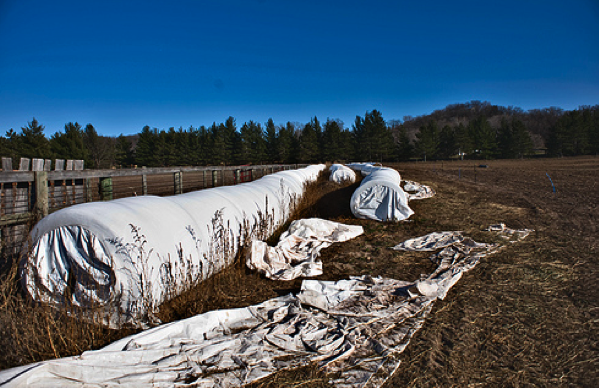Yesterday's post took a look at Thousand Hills Cattle Company and the advantages of grass fed beef.
There are purists who will argue that you can’t have pastured, grass-fed cattle in Minnesota all year round. These people have a point. Snow covers much of the ground in Minnesota for what seems like 6 - 8 months of the year. Thousand Hills Cattle Company, the largest producer of grass fed beef in the Midwest, deals with this harsh reality via a system of enormous hay bails, rolled up in the warmer months and rolled out across the snow during the winter.
 Photo Credit(s): Kate NG Sommers
Photo Credit(s): Kate NG Sommers
Visiting Thousand Hills Cattle Company was a great way to get me thinking about what issues are most important to me and why. These include:
- Grass fed - Does it matter what the cows eat? If cattle are meant to eat grass, is it okay to supplement their diet with corn? Why or why not? Is a grass fed diet the only way to ensure that cows don’t have stomach problems?
- Grass finished - Do I care if my cattle were finished on grass? Does this affect just their taste, or their lives in some way too?
- Pastured - Is it important to me that the cattle are free to roam? Absolutely! Although the raising of cattle ends in the harsh reality of the slaughterhouse, the lives the cows live before that matters to me.
- Organic - Is it important that cows eat only organic food? Am I okay with organic beef that was raised on corn rather than grass?
- Local - Thousand Hills Cattle comes from as far away as 400 miles. This distance considers the comfort and stress level of the cows, but also optimizes business. What is the ecological footprint of transporting cattle 400 miles? Does it offset the benefits of a grass fed diet, ecologically-speaking?
Eating mindfully forces us to consider the impact of our decisions, and to pick and choose those things that are most important to us.
The Local Challenge
What does it mean to eat local food? Minnesota’s Gold’n Plump and their recent “we’re local” campaign came up. It wasn’t too long ago that Gold’n Plump worked hard to shake the perception that they were a small, regional business. In an effort to compete with Tyson and the other big boys, the company was positioned as a national competitor, not a local player. But times have changed, and Gold’n Plump’s most recent advertising (along with their Just BARE Chicken) has been all about positioning themselves as a local company. Todd Churchill, founder of Thousand Hills, is just fine with that.
“It’s great that they’re local,” he says, “and people should know that, and people should support local companies if they want to. But being local means it’s easy to get answers to your questions. And for a company like Gold’n Plump, the story falls apart after just one question. That question is, ‘can I see the chickens?’ We’ve got to ask questions - and the right questions.”
Churchill is on a roll now. “Why is it that all our kids books present this beautiful image of what a farm is like? Why don’t they show industrial farms … [the way most of our meat is raised]? Let's have a scratch and sniff of an industrial hog farm. Here’s how it smells.”
I agree with Churchill (although I don't need to smell that book). As the word “local” gets twisted into whatever marketers want it to mean, it’s incumbent upon us to do a little bit of research, to ask questions, and to trust our instincts. To me, this last point is the most crucial. In the absence of time, information, or interest, it’s all too easy to put our faith in the side of a breakfast cereal box (“fortified with 8 essential vitamins and nutrients”). In fact, our instincts can be a far better guide. We should consider trusting them more often.




